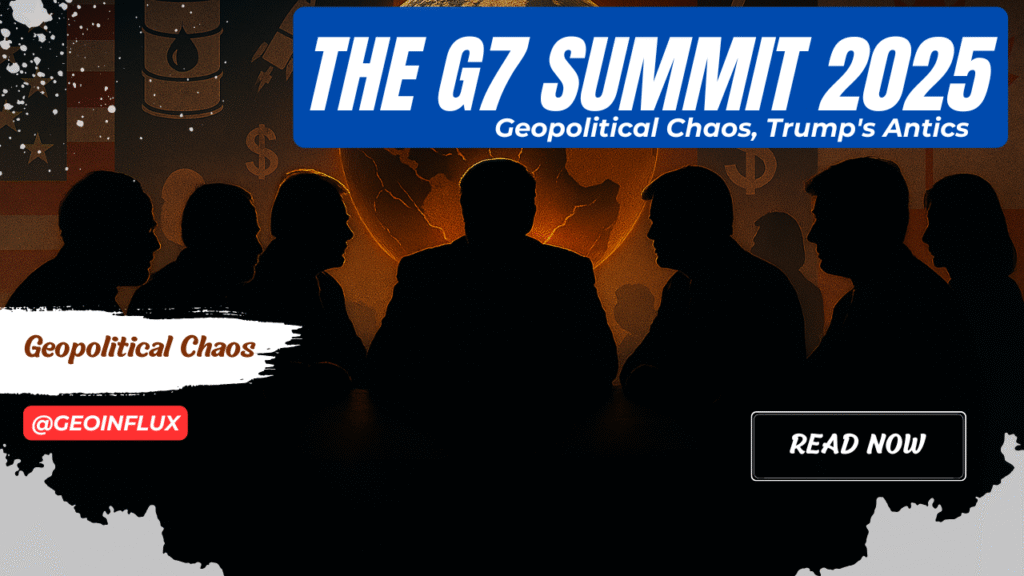The G7 Summit 2025: Geopolitical Chaos, Trump’s Antics, and India’s Strategic Clarity
The recent G7 Summit 2025, hosted by Canada, was expected to foster meaningful dialogue among world leaders. With Prime Minister Narendra Modi attending as a guest, global expectations were high. Yet, the summit unraveled quickly, spiraling into a spectacle that exposed growing geopolitical tensions, shifting alliances, and the volatile influence of Donald Trump’s foreign policy.
Trump’s Controversial G7 Summit 2025 Proposals
Before discussions even began, Trump dominated headlines by proposing an expansion of the G7 summit 2025 to include Russia and China. His call to revert the G7 back to a G8 by re-admitting Russia—removed after its annexation of Crimea—sparked backlash. He labeled the original expulsion as a “big mistake” by “Obama and some other person.”
Even more puzzling, Trump suggested expanding the G7 summit 2025 to a G9 by including China, despite routinely branding China as a global threat. These proposals conflict with the G7’s foundational purpose: a coalition of the world’s largest democratic economies. Russia, currently 11th in global GDP rankings, and the absence of India in Trump’s comments, underlines the flawed nature of this expansion logic.
A Summit Marred by Public Spats and a Fractured Front
Adding to the disorder, Trump’s early exit from the G7 summit 2025 was officially attributed to escalating tensions between Israel and Iran. However, French President Emmanuel Macron’s lighthearted jab—suggesting Trump was leaving to broker a ceasefire—struck a nerve. Trump responded angrily on social media, calling Macron a “publicity-seeking president” and insisting he had “much bigger” responsibilities.
This online spat, unfolding during a critical global summit, further tarnished the G7’s credibility. Trump’s claim of brokering 14 ceasefires between India and Pakistan—an assertion repeatedly denied by Indian officials—also resurfaced, causing diplomatic discomfort.
Implications for India’s Foreign Policy Strategy
Amid this confusion, India appears to have emerged with greater strategic clarity. Trump’s contradictions—simultaneously calling China a threat while advocating for its inclusion in G7 summit 2025—reinforce India’s growing mistrust in U.S. policy coherence.
India is now taking calculated steps:
- Defence Minister Rajnath Singh is set to attend the SCO Defence Ministers’ Summit in China.
- India is reassessing its stance on the RIC (Russia-India-China) bloc, which Russian officials are looking to revive.
If the U.S. openly considers adding China to its closest economic group, India is justified in deepening ties with emerging multilateral platforms like BRICS and RIC.
Rethinking India’s G7 Summit 2025 Participation
Given the summit’s circus-like atmosphere and lack of substantive progress, Indian analysts argue that future G7 summits may not warrant the Prime Minister’s presence. Instead, sending the External Affairs Minister may suffice, reserving the Prime Minister’s participation for more reliable global forums like the G20, which better align with India’s economic and strategic aspirations.
Moreover, the G7’s diminishing ability to foster consensus on global economic or security challenges makes its appeal to emerging powers like India increasingly tenuous. The group’s internal fragmentation, highlighted by Trump’s unilateralism and diverging interests among member states, suggests that India’s strategic bandwidth might be better invested in platforms where its voice carries more weight.
With India’s rapid ascent as the world’s fourth-largest economy, it deserves a seat at global high tables not as a guest, but as a core participant. Until the G7 reforms its membership to reflect today’s economic realities, India may prioritize multilateral mechanisms like G20, BRICS, and SCO, which offer more inclusive and balanced power dynamics.
Ultimately, New Delhi’s foreign policy posture must align with forums that value mutual respect, stability, and equitable decision-making—qualities increasingly absent from the current G7 configuration.
Key Takeaways: A Strategic Recap
G7 Summit 2025: Key Themes and Fallout
- G7 in Disarray
- Hosted by Canada; PM Modi attended.
- Undermined by Trump’s erratic conduct.
- Trump’s Controversial Suggestions
- G8: Add Russia (expelled after Crimea annexation).
- G9: Add China, contradicting anti-China rhetoric.
- No mention of India despite economic stature.
- Public Clashes
- Early departure due to Israel-Iran tensions.
- Macron’s “teasing” sparked angry Trump tweets.
- Trump’s India-Pakistan ceasefire claims dismissed by India.
- Impact on India’s Diplomacy
- Reinforces skepticism of U.S. dependability.
- Encourages stronger ties with RIC, BRICS.
- PM presence in G7 may be reconsidered.

